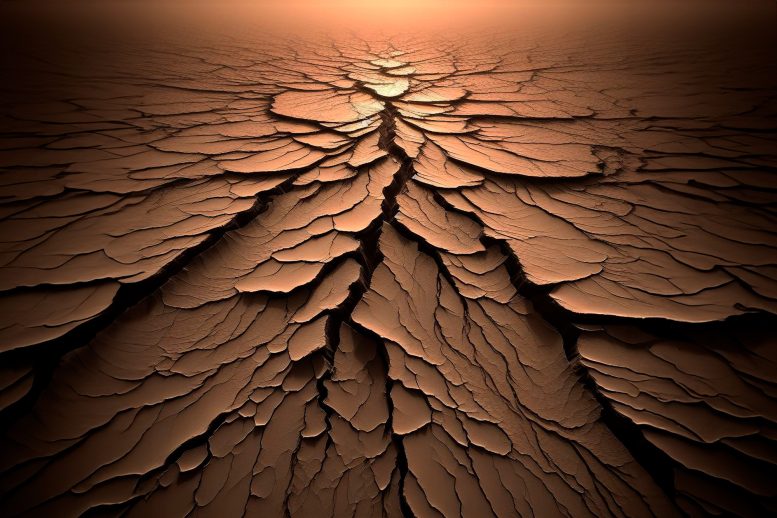Mars soil ‘hints’ at climate on Red Planet with lots of water
- July 12, 2024
- 0
Three billion years ago, the surface of Mars was rich in water and had a dense atmosphere – that is, there was a hydrological cycle and a full-fledged
Three billion years ago, the surface of Mars was rich in water and had a dense atmosphere – that is, there was a hydrological cycle and a full-fledged

Three billion years ago, the surface of Mars was rich in water and had a dense atmosphere – that is, there was a hydrological cycle and a full-fledged climate. But what exactly was it like? Hot and humid, like the terrestrial tropics, or cold and dry, like the Arctic and Antarctic? The diversity and image of the ecosystem that existed on the Red Planet depended on it. To answer these important questions, American geologists found soil on Earth similar to the Martian soil.
It is worth noting that it is most likely impossible to find exactly the same soil as Mars on Earth – the conditions on the two planets are too different. And of course they were different in the past. But each rock has its own history of formation, and this can be studied in more detail for terrestrial samples. Therefore, if you find soil similar to Mars on Earth, it would be possible to reasonably assume what conditions existed on the Red Planet before.
The rover has been operating in Gale Crater for almost 12 years Curiosity collected a large amount of data about the soils that are there. This area is the bottom of a lake that existed between four and three billion years ago.
Sedimentary rocks, minerals formed in the presence of water, and a special class of soils are found here: X-ray amorphous materials ( X-ray amorphous material This means that the X-ray diffraction in them is random, they do not have an ordered crystalline structure and are literally a gel-like porridge of various types of micro and nano particles. An important note: you should not confuse such materials with amorphous ones, these are different concepts.
Traveler Curiosity equipped with a tool Chemin (Chemistry and Mineralogy), designed, among other things, to study the structure of Martian minerals and rocks by X-ray diffraction. The results of its work show that the soils in Gale Crater consist of 15-73 percent by mass of X-ray amorphous materials. At the same time, their chemical composition is characteristic of ultrabasic rocks: they are characterized by a high content of iron (up to 43 percent) and silicon (up to 76 percent), but a low content of aluminum (less than 11 percent).
Another important feature of these soils is the presence of volatile components (water, carbon dioxide, and sulfur oxides), indicating their at least partly erosional origin.
Similar soils are not easy to find on Earth. High amounts of X-ray amorphous materials are found in glacial deposits, in Hawaiian soils, and in some places in the John Day Fossil Beds Reserve (Oregon). However, the chemical composition of these terrestrial soils is very different; in particular, they are much richer in aluminum.
Therefore, American geologists decided to first select samples of suitable chemical composition – weathered ultrabasic soils (serpentine), and then determine the content of X-ray amorphous materials in the soils formed by them.
The scientists chose the Klamath Mountains in California, the town of Pickhandle Gulch in the middle of the desert in Nevada (USA) and the Tablelands Mountains in Newfoundland (Canada). It was possible to find rocks with suitable chemical composition, but neither in the mountainous Mediterranean climate nor in the desert did scientists find sufficient X-ray amorphous material. Instead, the cold subarctic belt almost hit the apple. It was found that some Newfoundland soils have properties very similar to the Martian soils in Gale Crater.
This allows us to assume with great confidence that the climate of the Red Planet was dry and cool, with snowfall prevailing. At the same time, during the formation of X-ray amorphous rocks, that is, during a geologically significant period of hundreds of thousands or even millions of years, there were no large temperature differences on Mars.
The specific mechanisms of formation of such soils, as before, are not fully understood. Probably, the whole thing is a certain energy balance established between particles of X-ray amorphous materials in the presence of cold water close to the freezing point.
A scientific article with a detailed description of the research methods and results was published in the journal Contact World and EnvironmentThe text under review is in the public domain. Its authors include employees of the Desert Research Institute (DRI), Nevada State University in Las Vegas (UNLV), Lyndon Johnson Space Center (NASA JSC) and Arizona State University.
Source: Port Altele
As an experienced journalist and author, Mary has been reporting on the latest news and trends for over 5 years. With a passion for uncovering the stories behind the headlines, Mary has earned a reputation as a trusted voice in the world of journalism. Her writing style is insightful, engaging and thought-provoking, as she takes a deep dive into the most pressing issues of our time.